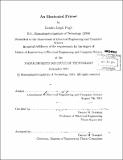| dc.contributor.advisor | Dennis M. Freeman. | en_US |
| dc.contributor.author | Pugh, Kendra Leigh | en_US |
| dc.contributor.other | Massachusetts Institute of Technology. Department of Electrical Engineering and Computer Science. | en_US |
| dc.date.accessioned | 2014-03-06T15:45:17Z | |
| dc.date.available | 2014-03-06T15:45:17Z | |
| dc.date.copyright | 2012 | en_US |
| dc.date.issued | 2012 | en_US |
| dc.identifier.uri | http://hdl.handle.net/1721.1/85483 | |
| dc.description | Thesis: M. Eng., Massachusetts Institute of Technology, Department of Electrical Engineering and Computer Science, 2012. | en_US |
| dc.description | Cataloged from PDF version of thesis. | en_US |
| dc.description | Includes bibliographical references (page 117). | en_US |
| dc.description.abstract | Educational technology has received unprecedented attention recently, as the efficacy of traditional education methods are coming into question. This thesis introduces the Primer - an e-textbook that initially customizes the presentation of a given course's content to the preferences of the reader, then gradually scales those customizations back as the reader progresses through the e-textbook. The Primer is designed to assist in the "two sigma" problem [1] of bringing the educational experience of a student closer to that of receiving individual instruction from a competent tutor that uses mastery learning techniques. The Primer initially improves the accessibility of a new course to the student by customizing the representation of the course's content to the student's needs; additional instructional videos, dereferencing of definitions, and hyperlinks back to the defining information originally introducting a concept are provided given the students' preferences. These customizations are based both on the strengths and weaknesses in the student's background in the course's preresequites, and the information presentation styles preferred by the student. The Primer reduces these customizations over the course of the textbook so that the e-textbook gradually and eventually reflects the delivery style intended by the e-textbook's author, and to give consistency across users' e-textbook experience. The goal is a method of information delivery that is personalized, yet standardized. The Primer allows students to ease into an e-textbook without becoming discouraged with the presentation style native to the e-textbook's field. It can prevent the student from becoming discouraged by providing more support for areas of the e-textbook's content in which the student has unstable grounding. The Primer was implemented using readings from 6.01 and additional content from OCW Scholar, and feedback was received from students as well as professionals in the field of educational technology. | en_US |
| dc.description.statementofresponsibility | by Kendra Leigh Pugh. | en_US |
| dc.format.extent | 117 pages | en_US |
| dc.language.iso | eng | en_US |
| dc.publisher | Massachusetts Institute of Technology | en_US |
| dc.rights | M.I.T. theses are protected by copyright. They may be viewed from this source for any purpose, but reproduction or distribution in any format is prohibited without written permission. See provided URL for inquiries about permission. | en_US |
| dc.rights.uri | http://dspace.mit.edu/handle/1721.1/7582 | en_US |
| dc.subject | Electrical Engineering and Computer Science. | en_US |
| dc.title | An illustrated primer | en_US |
| dc.type | Thesis | en_US |
| dc.description.degree | M. Eng. | en_US |
| dc.contributor.department | Massachusetts Institute of Technology. Department of Electrical Engineering and Computer Science | |
| dc.identifier.oclc | 870996869 | en_US |
